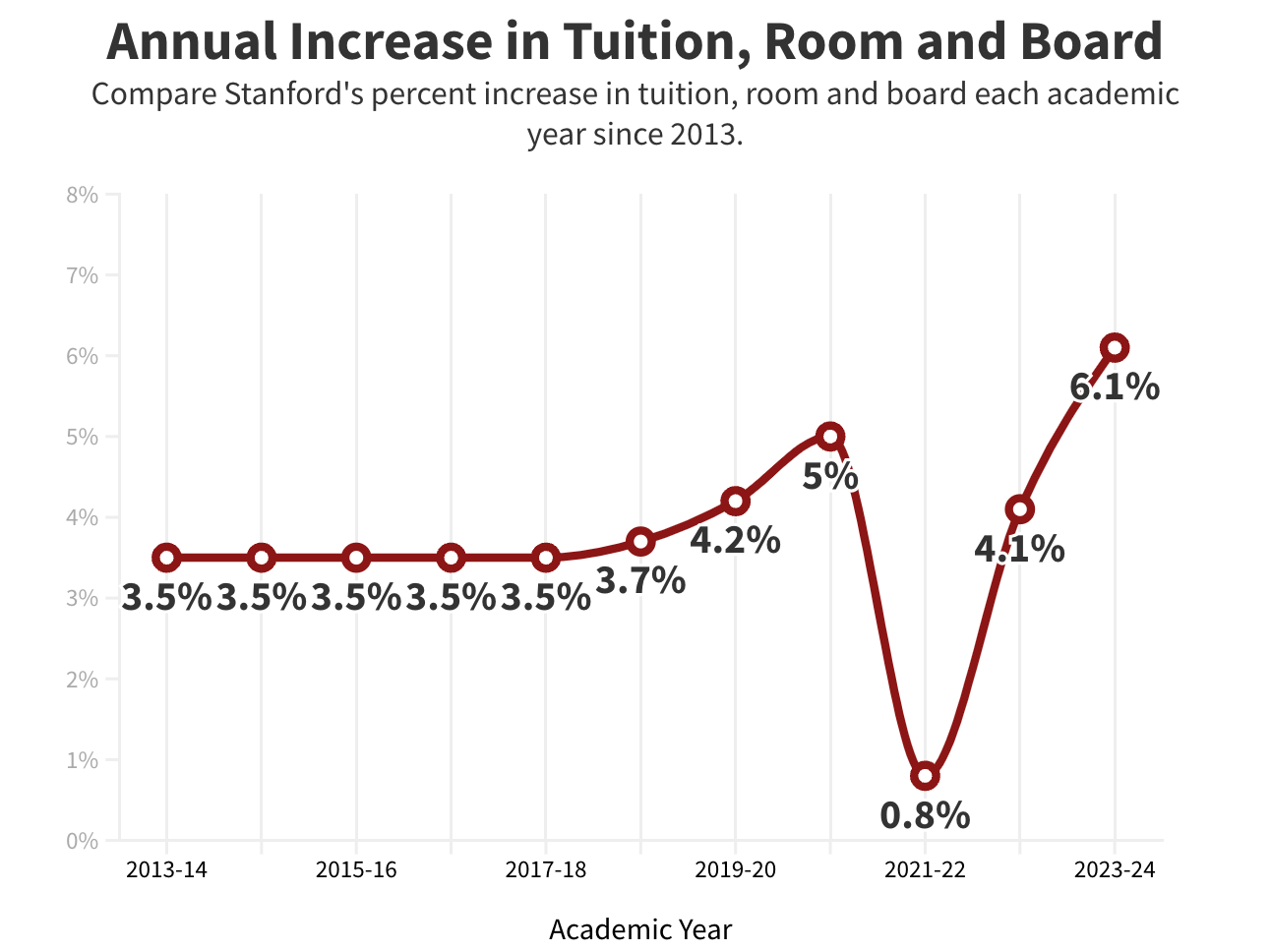Jonathan Levin, current Stanford Graduate School of Business dean, will serve as the University’s next president from Aug. 1, 2024. His appointment, announced in early April, will follow interim President Richard Saller’s short but tumultuous term and former President Marc Tessier-Lavigne’s leadership which came to an abrupt close.
As an Editorial Board, we’re excited to see how Levin’s relatively unique background will shape his tenure as Stanford president. As the first president to earn his undergraduate degree from Stanford since 1948, Levin is our first “home-grown” president in decades.
At 51, Levin is also be the fifth youngest Stanford president and a world-renowned researcher in microeconomics and industrial organization. With degrees in English, math and economics, Levin brings an expansive intellectual background that crosses many different disciplines.
The Presidential Search Committee and other stakeholders previously emphasized Levin’s early commitment to academic freedom on campus, aligned with principles advocated for previously by The Daily’s Editorial Board.
“As I look to Stanford’s future, I’m excited to strengthen our commitment to academic excellence and freedom; to foster the principles of openness, curiosity, and mutual respect,” Levin told Stanford News.
There are, however, many pressing issues facing Stanford in the years ahead that deserve our consideration as we transition to a new era of leadership.
Affordability
As The New York Times reported a few weeks ago, some American private undergraduate institutions will soon cost $100,000 per year. While Stanford offers excellent financial aid provisions for students who are U.S. citizens, our University is an outlier among peer institutions for its refusal to introduce need-blind admissions for international students.
Harvard, MIT, Yale and Princeton provide need-blind admissions for all applicants, regardless of nationality. With an endowment the same size as Sudan’s GDP, continued year-on-year hikes on tuition and room and board that far exceed the annual rate of inflation, and an explosion in the number of administrators, Stanford needs to justify the massive financial barrier it imposes on international students.
Additionally, Stanford-owned stores selling necessities charge prices ill-suited for students. Munger Market and Tresidder Marketplace, the only on-campus grocery stores, are prohibitively expensive. Prices at these stores are marked up significantly compared to off-campus stores. This is especially challenging for graduate students and students with dietary restrictions, many of whom cook instead of buying meal plans.
On-campus housing is also extremely costly for undergraduate and graduate students alike. At the same time, Stanford is cutting the quality of housing by cramming more students into less space. Residential and Dining Enterprises recent announcement about converting doubles and triples in Toyon and Roble into triples and quads in the upcoming year captures the problem.
Many undergraduates want the freedom to live with fewer roommates, and it is critical that Stanford maintains that option because it exerts power over the 97% of undergraduates who live on-campus.
Stanford needs to figure out how to get its financial house in order, and Levin can help us get there. Top-level administrative stances aimed toward addressing exorbitant tuition prices, unreasonable living costs and the housing availability crisis is a place to start.
The Editorial Board recommends Levin considers withdrawing more funding from the endowment to freeze annual tuition hikes for at least 1-3 years or bring it back to 3.5%, the rate from 2013 to 2018. Rather than placing the burden on individual students and families to finance Stanford’s expenditures, the administration should reassess how to best use its endowment.

A data visualization with data from Stanford’s financial aid office originally published in this article. The numbers may differ slightly from Stanford Report’s calculations as this graph only shows the cost of tuition, room and board. Stanford Report’s statistics may include or exclude certain fees. (Graphic: MARK ALLEN CU/The Stanford Daily)
Culture
Stanford has lost its juice. As students have widely lamented, Stanford’s culture is not the same as it was pre-pandemic. While Stanford’s undergraduate culture used to be synonymous with creativity, risk and irreverence, Friday nights are now nearly silent. Late Night at Arrillaga and Stern are gone, leaving students at dorm room desks instead of a dining room table filled with friends.
Recent student-led initiatives such as “In the Cards” newsletter, FLiCKs and the wildly successful On Call Cafe are huge steps in the right direction — these initiatives ought to continue receiving funding and admin support, and Levin can be the passionate advocate we need.
As someone who was once in our shoes, Levin ought to revive the parts of Stanford that make it feel like home. Levin can solicit more student input before Stanford offices spend huge amounts of money to overhaul campus life. The neighborhood system was a failed attempt to replicate the residential colleges at Yale and Oxford – a motivation heavily alluded to in the 2019 ResX report. The Stanford administration should have understood that the layout of campus is incompatible with a neighborhood system. Carving up the Row Houses into different neighborhoods, for example, artificially limited the availability of Row housing for students, which was already in high demand.
Students need a leader who can help Stanford find its identity again as it stands on its own. While we recognize that much of this revival of Stanford’s culture falls on our shoulders as students, we hope that Levin’s energy and Stanford roots can help him find ours.
Institutional neutrality
In times of turbulent global and domestic affairs, elite universities like Stanford have been put under tremendous pressure by its students, the public and even the U.S. government to make public statements expressing stances on current events.
Stanford’s president will need to navigate a campus climate in which the opinions of Stanford students and faculty alike are scrutinized by the public. So far, bodies like the Faculty Senate and Undergraduate Senate have faced the brunt of this work rather than the president.
Although the office of the president has released statements on issues directly concerning universities, it has generally refrained from voicing opinions on global issues. For example, former President Marc Tessier-Lavigne gave remarks about the Russian invasion of Ukraine to the Faculty Senate but did not issue a university-wide statement.
Going forward, we encourage Levin to carry forth the spirit of institutional neutrality and academic freedom that Saller and Provost Jenny Martinez articulated in a judicious statement from October 2023.
Stanford as a pioneer for public good
While Harvard and Yale struggle to fill vacant presidencies, Stanford is ready to begin a new, hopeful era under Levin’s leadership. Saller and Tessier-Lavigne were forced to be on the defensive during their tenures: Saller had to navigate student protests and free speech regulations, while Tessier-Lavigne had to defend his academic reputation. Now, we have the opportunity to be led by a president who starts with a blank slate and can drive change at Stanford.
American society now regards universities with a more cautious eye. There is a rising trend among some Americans to claim that “colleges have a negative effect on the U.S.,” according to Pew Research Center. Though the Editorial Board staunchly disagrees with that claim, we recognize that scandals involving top Stanford leaders and famous Stanford alumni have brought into question Stanford’s ability to cultivate ethical leaders who advance the public good.
In recent years, skeptics have argued that many elite institutions in our country are turning into hedge funds with research labs attached. Universities are getting stretched thin to appease as many stakeholders as possible, perhaps out of necessity given their operating costs which increase nearly every year. The Editorial Board worries that this may lead to a neglect of student interests, and we ask that Dr. Levin prioritize mission-driven student education.
We want a president who can restore the public’s faith that Stanford is and will continue to enhance and contribute to the generation of knowledge and the development of leaders who improve society. We hope Levin can usher Stanford into a period of leadership that revives Stanford’s promise to promote “the welfare of people everywhere.”
